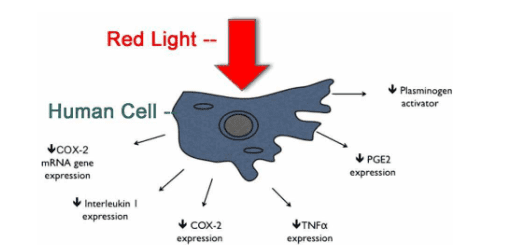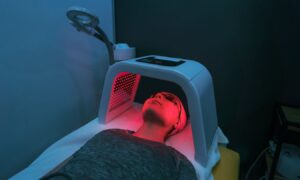Light therapy using red or infrared light has been well-studied for infections (both fungal and bacterial types) in various diseases. The relationship between red light therapy and infections is a lot clearer than before, and related conditions include vaginal fungus, jock itch, inflammation of the glans penis, nail infections, ringworms, swimmer’s eczema, and so on. In this blog, we will discuss how red light therapy can help infectious diseases. We will also discuss why receiving red light therapy at home is a good option for you to get rid of the infection.
What are fungal and bacterial cells?
Bacteria are microscopic, unicellular organisms that are virtually ubiquitous on Earth. Some bacteria are beneficial to human bodies because they keep the digestive system functioning properly and prevent the entry of dangerous germs. Some bacteria are employed in the production of drugs and vaccinations. Extreme environmental factors, including high pressure, low pH, and temperature, don’t stop some bacterial species from growing. However, bacteria can also be a problem, as seen in cases of strep throat, cavities, and urinary tract infections. Bacterial infections are treated with antibiotics.
Fungi are microscopic multicellular or unicellular organisms. The majority of fungi are found in soil and on dead creatures, and they are essential for mineralizing organic carbon. Opportunistic pathogens include fungi. However, the majority of fungi break down and degrade dead plants, animals, and food. Many common fungal infections, including fungal nail infections and yeast infections, are not harmful to healthy people. However, those with weakened immune systems (caused by conditions like cancer or HIV) are more likely to develop deadly fungus infections. There is a study that gives an overview of various fungal diseases and a summary of the disease mechanisms of fungi.
How can red light therapy help with infection?
Red light therapy reduces inflammation
Because the immune system works to protect the body against aggressive germs, redness, pain, and itching are typical signs of infections. The tension created by this interaction on the local tissue causes further inflammation, which in turn promotes the growth of fungi. Anti-inflammatory components are usually included in many prescriptions and ointments to treat infections, such as hydrocortisone. Red light may aid the body in addressing metabolic causes of inflammation, enabling cells to produce more ATP and CO2 from the cellular respiration process. The end products of the respiration mechanism have effects that are quite similar to those of anti-inflammatory substances. They prevent the release of certain inflammatory cytokines as well as the creation of prostaglandins, an essential mediator of the inflammatory response. The picture below shows the effect of red light therapy on inflammatory cytokines.
Red light therapy harms fungi and bacteria
Red light therapy can directly destroy fungi or bacteria in a dose-dependent manner. The endogenous light-sensitive components that are already present in microorganisms will interact with red or near-infrared light in the fungal cells, causing a destructive reaction that eventually kills the fungi. Additionally, fungal treatments by red light therapy are often applied in combination with light-sensitive chemicals in many clinical cases, known as “photodynamic therapy,” to enhance the fungus-killing effects of red light. This is a study that looked into photodynamic therapy for a variety of fungal infections. Patients who experienced recurrent infections were observed to recover without inflammation and sterilization of the skin from harmful microorganisms after the administration of red light and to have healthier skin and better resistance to future infections. The result showed a dose-dependent manner: treatment using high doses of light and high concentrations of photosensitizer leads to cell death by necrosis, while treatment with low doses tends to induce cell death by apoptosis.
How to use red light therapy at home for infection
What specific type of light wavelength do you need?
Almost all research on this concern used red light in the band of wavelengths between 660 – 685 nm. Some studies used a particular wavelength of near-infrared light alone (780 nm, 830 nm, 870 nm, or 980 nm) with nearly the same results per dose applied. With the research outcomes so far, it seems that red light provides more anti-inflammatory effects, whereas infrared light likely offers a barely higher fungus-killing effect. The differences, however, are minor. Both anti-inflammatory and anti-fungal effects are equally essential to clear up fungal infections, and using the combination of red and near-infrared light provides a better result. Infrared light has better penetration ability, so it is much preferable to treat deeper fungal infections such as those in the vagina or mouth.
How do you use red light therapy at home for infection?
Numerous studies showed that the antifungal properties of red light therapy showed a dose-dependent reaction. A higher dose of light is more effective in destroying fungal infections and also resolving inflammation.
With most clinical trials using irradiance at least greater than 48 mW/cm^2, a majority of cases using a higher irradiance of 80–120 mW.cm^2, it is highly recommended to use a light source with an irradiance output of not less than 90 mW/cm^2 to achieve the desired effects and better efficacy.
Why Bestqool red light therapy devices
Fungal infections are widespread and can be quite debilitating. If left untreated, they can cause inflammation and even lead to more serious conditions like cancer. That’s where red and near-infrared light therapy devices come in. These devices emit a specific wavelength of red light that is known to kill fungal organisms.
Bestqool aims to only manufacture medical-grade professional red light therapy devices for treatment purposes. Bestqool offers a wide range of red light therapy devices that have specialties for different diseases and conditions.
Most importantly, all Bestqool products are applied with advanced LED technology to deliver the wavelengths that are highly suggested as the most effective in most studies, i.e., red light at 660 nm and 830 nm with an adequate irradiance level to meet the highest performance of the industry in this field, at 100 mW/cm^2 as the direct output in our latest model.
The killing-fungal properties of red light therapy show a dose-dependent manner, which means a higher irradiance can provide better efficacy in healing infection. All Bestqool products are FDA-registered as FDA Class II medical devices and supervised by authoritative bodies to ensure the claimed therapeutic effects. All Bestqool products are also ETL-certified, which put a guard on the safety of electrical medical devices. Furthermore, for better customer satisfaction all Bestqool products offer a three-year warranty, longer than any other company in this market, which means that you can be sure you’re making the best decision for your health.






































